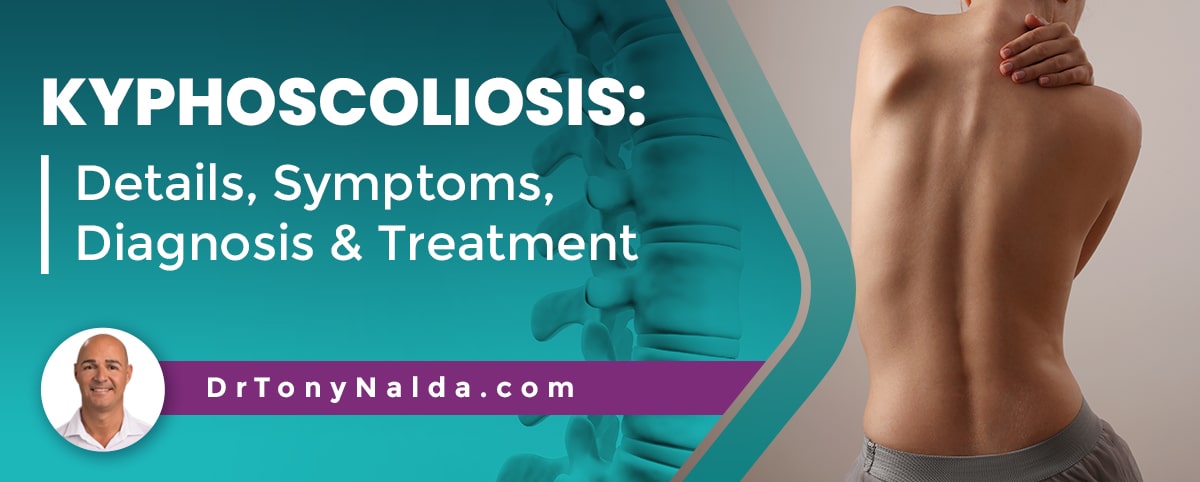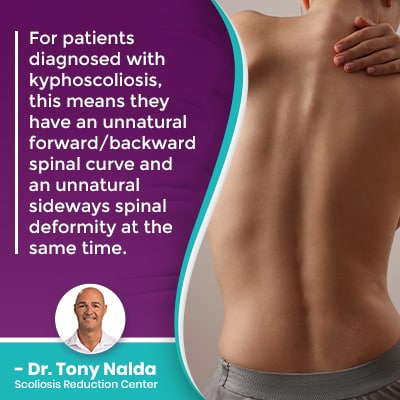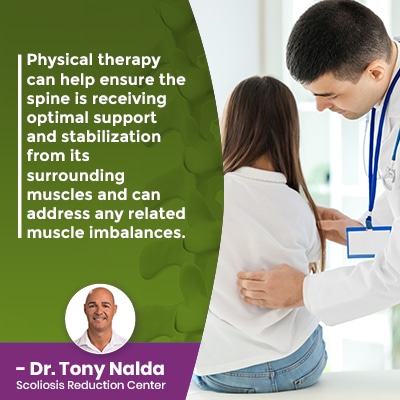Kyphoscoliosis: Details, Symptoms, Diagnosis & Treatment

The spine's natural curves make it stronger, more flexible, and better able to handle mechanical stress incurred during movement. Kyphosis is the development of an excessive outward-rounding spinal curve of the upper back, and scoliosis involves the development of an unnatural lateral spinal curve with rotation; continue reading to find out what happens when a combination of the two develops.
The spine's healthy curves are key to maintaining its natural strength and function; as such, there are a number of spinal conditions that involve a loss of the spine's healthy curves. Kyphosis and scoliosis are two prevalent spinal conditions, and kyphoscoliosis is a combination of the two.
Let's start by breaking down the term kyphoscoliosis by defining each condition.
Table of Contents
What is Kyphosis?
If a healthy spine was viewed from the front and/or back, it would appear straight, but when viewed from the sides, it would take on a soft 'S' shape, and this is because of the spine's natural and healthy curves.
There are three main spinal sections, each with its own unique curvature type: cervical spine (neck), thoracic spine (middle/upper back), and the lumbar spine (lower back).
Each spinal section's curve is dependent on the health of the others, which is why the loss of a single healthy spinal curve can disrupt the biomechanics of the entire spine.
Not only does the spine allow us to stand upright, practice good posture, and engage in flexible movement, it also works in tandem with the brain to form the central nervous system (CNS), which is why spinal conditions can affect the body in a number of ways.
The two main curvature types are known as kyphosis and lordosis.
Lordosis refers to the spinal curves at the cervical and lumbar sections that bend inwards, towards the body's center in a standard 'C' shape, and kyphosis refers to the curvature of the thoracic spine that bends outwards, away from the body's center, in a reverse 'C' shape.
While there is a healthy range of curvature sizes, measured in degrees, when kyphosis falls beyond a normal range, and in severe cases, the thoracic spine can develop an arch, giving the upper back and shoulders a rounded-forward posture, also commonly referred to as roundback.
There are also different types of kyphosis, determined by causation, with the most common being postural kyphosis, Scheuermann's kyphosis, and congenital kyphosis.
Now that we've defined kyphosis, let's move on to the most prevalent spinal condition amongst school-aged children: scoliosis.
What is Scoliosis?
The Scoliosis Research Society puts current estimates at close to seven million people living with scoliosis in the United States alone.
Scoliosis is a structural spinal condition that involves the development of an unnatural lateral (sideways) spinal curve, with rotation, making it a complex 3-dimensional condition with the spine both bending and twisting unnaturally.
The unnatural spinal curve has to be of a minimum size to be diagnosed as scoliosis: Cobb angle measurement of at least 10 degrees.
A patient's Cobb angle is determined during X-ray by drawing lines from the tops and bottoms of the curve's most-tilted vertebrae (bones of the spine), and the resulting angle is expressed in degrees.
The higher the Cobb angle, the more out of alignment the spine is, and the more severe the condition:
- Mild scoliosis: Cobb angle measurement of between 10 and 25 degrees
- Moderate scoliosis: Cobb angle measurement of between 25 and 40 degrees
- Severe scoliosis: Cobb angle measurement of 40+ degrees
- Very-severe scoliosis: Cobb angle measurement of 80+ degrees
The important thing to understand about scoliosis is that it's a progressive condition, meaning it has it in its nature to worsen over time, especially if left untreated, or not treated proactively.
Scoliosis progressing means the unnatural spinal curve is increasing in size, introducing more and more uneven forces to the body, and related effects will also increase; the main symptom of scoliosis in children is postural deviation, and the main symptom of scoliosis in adults is pain.
In addition to scoliosis ranging widely in severity, there are also different condition types: idiopathic scoliosis, neuromuscular scoliosis, degenerative scoliosis, and congenital scoliosis.
Now that we've defined scoliosis, and discussed some of its defining features, let's address what happens when a person develops kyphosis and scoliosis suddenly at the same time.
What is Kyphoscoliosis?
When two spinal conditions develop at the same time, it can result in the development of a severe spinal deformity, complicating the treatment process.
An abnormal curvature of the spine can affect the body in a number of ways, so how would having two unnatural spinal curves, simultaneously, impact a person's health?
 For patients diagnosed with kyphoscoliosis, this means they have an unnatural forward/backward spinal curve and an unnatural sideways spinal deformity at the same time.
For patients diagnosed with kyphoscoliosis, this means they have an unnatural forward/backward spinal curve and an unnatural sideways spinal deformity at the same time.
Symptoms of kyphoscoliosis will vary based on important variables such a patient age, condition type, and severity, but common kyphoscoliosis symptoms can include:
- Excessively rounded-forward shoulders and upper back
- Difficulty standing for long periods of time
- Uneven shoulders and shoulder blades
- The development of a rib arch
- Uneven hips
- Arms and legs that appear to hang at different lengths
- Back pain
- Bad posture
Now, in particularly severe kyphoscoliosis cases, and/or if left untreated, kyphoscoliosis can cause further damage and is associated with the following symptoms and potential complications:
- Respiratory decline
- Reduced lung volume
- Respiratory failure
- Excessive fatigue
- Muscle spasms
- Muscle weakness
- Neurologic deterioration
- Neurological issues
- Cardiac issues (right ventricular overload)
- Pulmonary arterial hypertension
So as you can see, kyphoscoliosis can cause a number of issues, especially if left untreated to progress unimpeded.
So what can be done about kyphoscoliosis in terms of treatment?
Kyphoscoliosis Treatment Options
As there are so many variables that factor into how kyphoscoliosis is experienced, treatment plans have to be fully customized to address those key patient/condition factors: patient age, postural habits, severity, and the condition's underlying cause.
When treating kyphoscoliosis in children, a focus of treatment is monitoring how the spine is responding to growth and treatment; growth is the condition's main trigger for progression.
Here at the Scoliosis Reduction Center, I treat a patient's condition with a conservative chiropractic-centered treatment approach that values being proactive by starting treatment as close to the time of diagnosis as possible.
I want my patients to benefit from what different condition-specific treatment disciplines have to offer, so I integrate multiple forms of treatment into treatment plans.
Chiropractic Care
Chiropractic care involves a series of techniques and manual adjustments that work towards adjusting the position of the curve's most-tilted vertebrae back into alignment with the rest of the spine.
By improving the spine's alignment, as much of its healthy curves as possible are restored, improving the spine's biomechanics and health.
As kyphoscoliosis involves structural abnormalities within the spine itself, treatment has to, first and foremost, impact it on a structural level: achieved through curvature reductions.
Physical Therapy
Kyphoscoliosis doesn't just affect the spine, but also its surrounding nerves, ligaments, and muscles.
It's not just the spine that has to maintain its natural curves and alignment, but also its surrounding muscles, and when the spine is unnaturally curved, the spine's surrounding muscles can become strained as they struggle to support the spine, and a muscle imbalance can develop: muscles on one side of the spine can become stretched and loose from overuse, while the muscles on the opposite side can become weak from underuse.
Physical therapy can also help improve brain-body communication for better posture.
 Physical therapy can help ensure the spine is receiving optimal support and stabilization from its surrounding muscles and can address any related muscle imbalances.
Physical therapy can help ensure the spine is receiving optimal support and stabilization from its surrounding muscles and can address any related muscle imbalances.
Corrective Bracing
Corrective bracing can be particularly effective on growing spines, and when combined with other forms of corrective treatment, it can help augment those results by pushing the spine into a corrective position.
Corrective bracing can also help prevent kyphoscoliosis from progressing.
Rehabilitation
A series of custom-prescribed exercises can help patients establish a home-rehabilitation program to further stabilize the spine and maintain spinal flexibility.
Conclusion
Scoliosis is the development of an unnatural sideways spinal curve that also rotates, and has a minimum Cobb angle measurement of 10 degrees.
Kyphosis, aka hyperkyphosis, is the development of excessive thoracic kyphosis, causing the upper back and shoulders to round forward excessively.
A diagnosis of thoracic kyphoscoliosis means the thoracic spine has two unnatural spinal curves simultaneously: an unnatural sideways scoliotic curve, and an unnatural kyphotic curve of the middle/upper back.
When the spine is curved unnaturally, it can compress the spinal canal, which exposes the nerves within to uneven pressure, and this can cause varying levels of back pain, and pain that radiates into the body's extremities.
There are multiple factors that play into how a patient will respond to treatment, and while there are no treatment guarantees, early detection and intervention does increase chances of treatment success.
When treated proactively, and impacted on a structural level, structural causes are addressed, while additional treatment disciplines such as physical therapy and corrective bracing can help augment corrective results by guiding the spine's positioning and increasing its surrounding muscle strength for optimal support.
Dr. Tony Nalda
DOCTOR OF CHIROPRACTIC
After receiving an undergraduate degree in psychology and his Doctorate of Chiropractic from Life University, Dr. Nalda settled in Celebration, Florida and proceeded to build one of Central Florida’s most successful chiropractic clinics.
His experience with patients suffering from scoliosis, and the confusion and frustration they faced, led him to seek a specialty in scoliosis care. In 2006 he completed his Intensive Care Certification from CLEAR Institute, a leading scoliosis educational and certification center.
About Dr. Tony Nalda
 Ready to explore scoliosis treatment? Contact Us Now
Ready to explore scoliosis treatment? Contact Us Now





